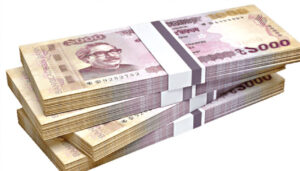 Md Shahadat Hossain : THE Bangladesh Bank injected Tk 70,000 crore as new money, also known as printed money, into circulation in the first 11 months of the last fiscal year 2022-2023 to support the government’s budget expenditure. The objective of the continuous injection of such new money into circulation was to keep the interest rate on Treasury bills and bonds below 9 per cent. The circulation of new money increased domestic asset growth, which fueled inflation at 9.33 per cent in March 2023, the highest in the last eight months. An abnormal rate of inflation erodes the value of real wages and savings, making households poorer and creating a cost-of-living crisis. In a nutshell, inflation is an incidence that is able to push the economy into turbulence.
Md Shahadat Hossain : THE Bangladesh Bank injected Tk 70,000 crore as new money, also known as printed money, into circulation in the first 11 months of the last fiscal year 2022-2023 to support the government’s budget expenditure. The objective of the continuous injection of such new money into circulation was to keep the interest rate on Treasury bills and bonds below 9 per cent. The circulation of new money increased domestic asset growth, which fueled inflation at 9.33 per cent in March 2023, the highest in the last eight months. An abnormal rate of inflation erodes the value of real wages and savings, making households poorer and creating a cost-of-living crisis. In a nutshell, inflation is an incidence that is able to push the economy into turbulence.
But is it the only source of money liable for such economic crises as inflation? We know there are various resources available to the government to meet budget expenses. These are: direct tax, indirect tax, foreign loan, local loan, and money printing. If we rank the sources of funds according to their merit, the direct tax may be ranked as an excellent resource, the indirect tax may be a very good resource, a foreign loan may be a good resource, local debt may be ranked as a bad but acceptable resource, and new money, i.e., printing money, may be ranked as the worst and most unacceptable resource. The main objective of this write up is to make one understand that for meeting up the government budget expenditure, the resource of the fund is not the only considerable factor; another important consideration is the utilisation of the fund, i.e., what expenditures are being met up by the fund.
For the betterment of the economy of the country, the utilisation of all the funds, especially development expenditures, should be productive, foreign currency earnings or savings-oriented, and create the utility of the products. If the government’s budget expenditure is productive, whatever the sources, it is not an issue. Suppose, in a particular period of time, the total foreign currency reserve of a country is $1,000 for the import of fuel for transportation, the total circulation of its own currency is CU5,000, and stock of commodities is 1,000 kilograms with an average price of CU5 per kg. The population density of the country is very high, with heavy traffic congestion. The government of that country plans to build an elevated expressway but there is no source of funding in the form of direct or indirect tax, foreign, or local loansThe government plans to print a new currency of CU1,000 to build the elevated express way and accordingly, it does so.
According to the nature of the source of funding, the inflation should have been at least 20 per cent [(CU1000 ÷ CU5000) x 100] but there might be no inflation because due to the construction of the new elevated motorway, traffic congestion will reduce substantially and increase the efficiency of the people, resulting in an increase in exports amounting to $200 and the fuel cost will reduce to $300. With this extra earned and saved foreign currency of $500, the government will be able to import 200 kilograms of extra commodities. After building the elevated expressway, the circulation of local currency in the country will arrive (CU5,000 + CU1,000) = 6,000 and the quantity of commodities will stand at (1,000 kilogram + 200 kilogram) = 1,200 kilogram and the commodity price will remain the same as CU5 per kilogram, having no effect of inflation.
Conversely, in the above example, had the fund of CU1,000 been collected in the form of direct and indirect tax and spent for unproductive and unusable purposes like building a couple of incomplete bridges, there would have been no scope for demand-pull inflation due to the absence of excess money circulation, but the cost-push inflation would have taken place due to the increase in the price of commodities by imposing indirect tax. The productivity of government expenditures or development projects is measured in different ways. A project can help you increase production, earn foreign currency, save foreign currency, and improve your place and time utility.
In the context of Bangladesh, projects in power and automation may facilitate increasing the production of commodities; projects in tourism may facilitate increasing the earnings of foreign currency; projects in the health sector may facilitate saving foreign currency; smooth communication projects like highways may facilitate the creation of place utility for commodities; and the construction of cold storage may facilitate the creation of time utility for commodities. For the economic development of the country, all the development projects mentioned above are very essential. Sources of funding in our country are very limited. Each and every year, targets for the collection of direct and indirect taxes and loans from foreign lending agencies are not achieved. In the past, the demand of fund for government expenditure was met through loans from commercial banks, the sale of national saving certificates, and printing new money. Undoubtedly, this practice is not good for the economy of the country.
What is unacceptable is that under this funding circumstance, it has been observed that lots of development projects in our country were completed that are not now being used and have no contribution to the economy. From this practice, it may be said that printed money is not the only cause of inflation that has taken place in the country. The authorities pay attention and importance mostly to the sources of funds during the preparation of the national budget and during review by the stakeholders, but neither due care nor proper attention is given to the nature of expenditure by any stakeholder in respect of improper expenditure. As a result, people do not get the maximum benefit from the development activities of the budget. It may be concluded that even the worst-ranked source of the funds, such as printing money, utilised in financially-viable projects is better than the excellent-ranked sources of the funds utilised for financially unviable projects.
Md Shahadat Hossain is a former president of The Institute of Chartered Accountants of Bangladesh.









